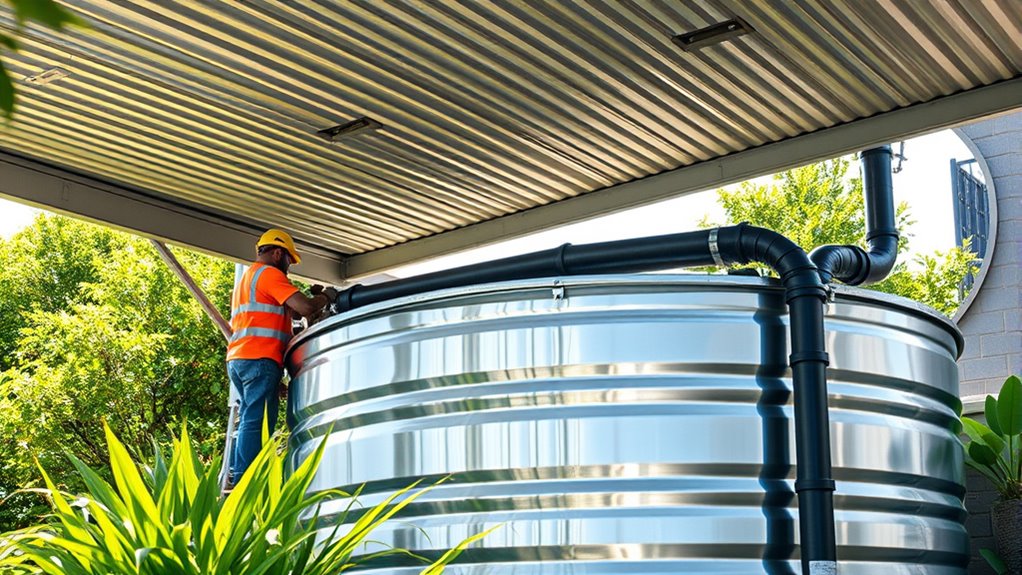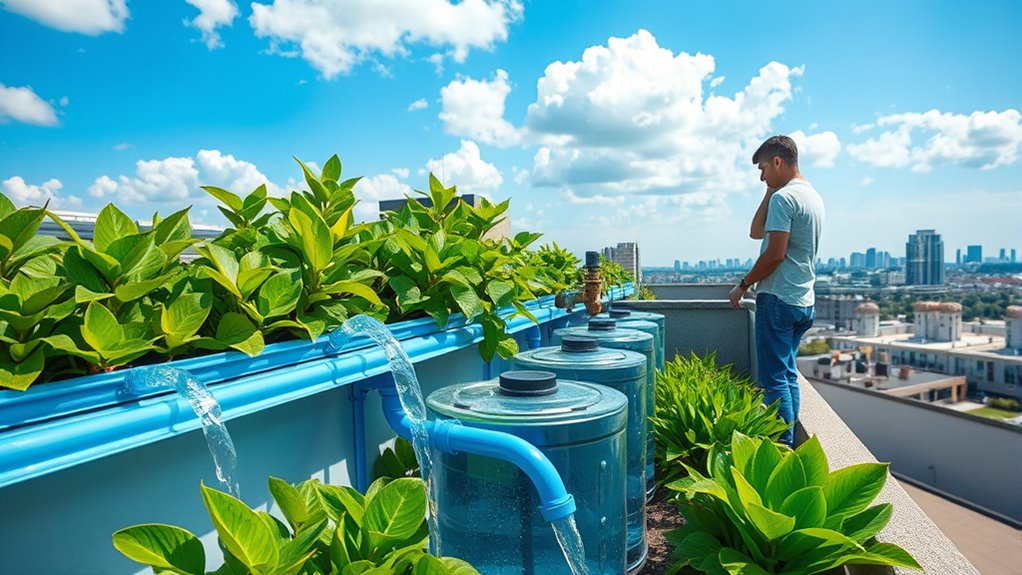To build a rainwater harvesting system, start by installing durable gutters and downspouts to channel rainwater into storage tanks placed in shaded, accessible areas. Use screens or first-flush diverters to remove debris, and select UV-resistant, food-grade tanks for safe storage. Regularly maintain and clean your filters and tanks to keep water quality high. Incorporating proper filtration and stormwater management helps conserve water and reduce runoff, and exploring these steps further will guide you on creating an effective system.
Key Takeaways
- Select durable, non-toxic roofing materials and install gutters to effectively collect rainwater.
- Install first-flush diverters and mesh filters to remove debris and improve water quality.
- Choose UV-resistant, food-grade tanks placed in shaded areas for safe, algae-free storage.
- Incorporate pumps or gravity outlets for convenient access and ensure regular inspection and cleaning.
- Connect the system to stormwater management strategies to reduce runoff and support sustainable urban development.

Have you ever considered how capturing rainwater can benefit your home or community? Building a rainwater harvesting system not only reduces your reliance on municipal water supplies but also plays a essential role in stormwater management. When you collect rainwater effectively, you help prevent runoff that can overwhelm drainage systems, cause erosion, and carry pollutants into local waterways. Implementing a well-designed system allows you to capture, store, and use rainwater efficiently while minimizing environmental impact.
Capturing rainwater benefits your home and community by reducing runoff and supporting stormwater management.
The first step in building your system is choosing the right collection surface, typically a roof made of durable, non-toxic materials. From there, you’ll need gutters and downspouts to direct the flow of rainwater into your storage tanks. Making sure these components are properly installed and maintained is critical for efficient collection. Once the water is captured, filtration techniques come into play. Installing screens or first-flush diverters helps remove debris, leaves, and other larger particles before the water reaches your storage. For finer filtration, consider using mesh filters or charcoal-based filters that remove sediments and improve water quality. These filtration techniques are essential to keep your stored water clean and safe for various uses, such as watering plants, washing cars, or even for household chores if properly treated.
Storing rainwater properly is equally important. You should select tanks made of food-grade, UV-resistant materials to prevent algae growth and contamination. Position your tanks in shaded areas to further inhibit algae development and ensure easy access for maintenance. Regular inspection and cleaning of filters, screens, and tanks guarantee the system remains functional and efficient. Incorporating a pump or gravity-fed outlet allows you to draw water as needed, making it convenient for daily use. Additionally, understanding the role of contrast ratio in projectors can help you select appropriate display equipment if you plan to showcase your system or related educational content visually.
Furthermore, integrating your rainwater harvesting system with existing stormwater management strategies enhances its benefits. By diverting runoff into your tanks, you reduce the volume of water that enters storm drains during heavy rains, alleviating pressure on municipal systems and decreasing flood risks. This approach not only conserves water but also supports sustainable urban development.
Frequently Asked Questions
What Are the Legal Regulations for Rainwater Harvesting in My Area?
You should check your local laws to guarantee legal compliance and understand permitting requirements. Regulations vary by area, and some places may need you to obtain permits before collecting rainwater. It’s essential to contact your local government or water authority to verify rules, as ignoring legal requirements could lead to fines or project delays. Staying informed about your area’s policies helps you build your rainwater harvesting system legally and smoothly.
How Often Should I Clean and Maintain the System?
Oh, because maintaining your system is obviously a tedious task, right? You should clean and inspect your rainwater harvesting system at least every six months. Don’t forget filter maintenance—clogged filters can turn your pure water into a muddy mess. Stick to a regular cleaning schedule to keep everything running smoothly, prevent buildup, and guarantee your system’s efficiency. After all, who wouldn’t want to enjoy clean water without constant worry?
Can the System Be Integrated With Existing Plumbing?
You can definitely integrate your rainwater harvesting system with existing plumbing. First, check system compatibility to guarantee the components work together smoothly. Plumbing integration involves connecting the harvested water to your current plumbing setup, which might require installing a diverter or filter. Always consult local codes and consider professional help to ensure a safe, efficient integration that maximizes water use without compromising your household plumbing.
What Are the Costs Involved in Installing a Rainwater Harvesting System?
Imagine balancing a tightrope of costs and savings. You’ll need a cost analysis to understand initial expenses like collection tanks, filters, and installation, alongside ongoing maintenance. Budget planning helps you allocate funds wisely, considering materials and labor. While costs vary based on system size and complexity, investing wisely guarantees future water savings. With careful planning, you can make the project affordable and sustainable, turning rain into a valuable resource.
How Much Rainfall Is Needed to Make the System Effective?
You need to consider the rainfall amount to ensure effective collection. Generally, an average of at least 20 inches of annual rainfall is necessary for a rainwater harvesting system to be worthwhile. More rainfall improves the system’s efficiency, providing a consistent water supply. If your area receives less, you might need supplemental sources or larger storage to maximize effective collection. Monitoring local rainfall patterns helps determine if your system will meet your needs.
Conclusion
By building your rainwater harvesting system, you’re creating a sustainable oasis, like a hidden treasure chest filled with nature’s gift. With simple steps and a bit of effort, you transform your space into a water-saving sanctuary. Every drop you collect is like catching sunlight in a jar—precious and full of potential. So, take action today and turn rain into a resource that nurtures your home and the environment for years to come.









